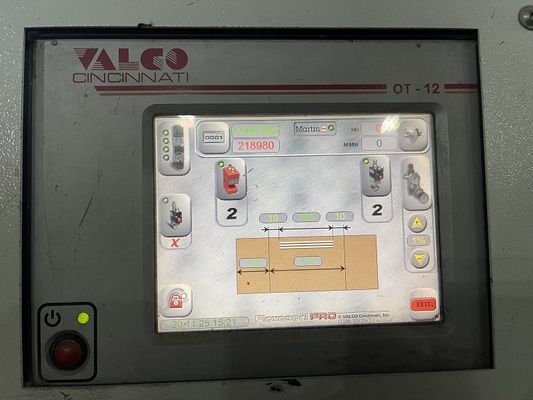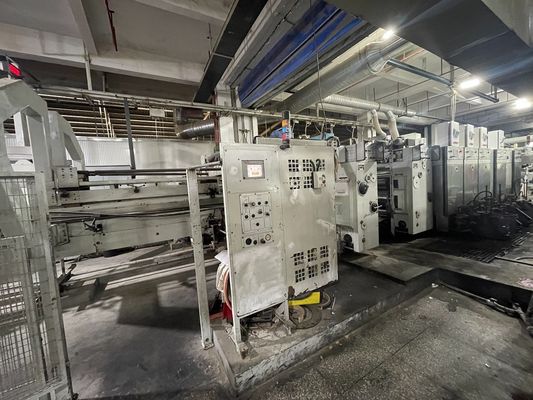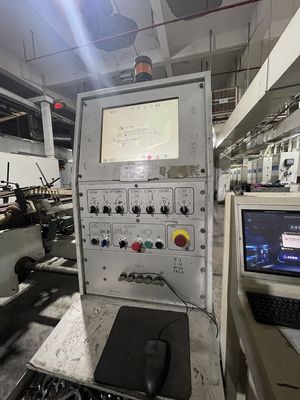Second hand martin bottom printing slotter die cutter inline gluer machine to sale
Model:924
Year:2013
whatsapp pls contact +8613928813765
How to repaire Martin machine
This guide is structured from basic troubleshooting to complex repairs.
I. The Foundation: Troubleshooting Before Repair
Many "repairs" start with identifying the root cause. Always follow a systematic approach:
1. Talk to the Operator: They were there when the problem started. What did they see or hear?
2. Observe the Machine: Run it slowly and watch. Look for misalignments, unusual sounds, or visual defects on the sheets.
3. Identify the Pattern: Is the defect consistent? Is it on every sheet, or intermittent? This points to a mechanical (consistent) vs. control/servo (intermittent) issue.
4. Check the Simple Things First: Is there air pressure? Are the brakes engaged? Is a safety guard not fully closed? Is the sheet gap setting correct?
---
II. Common Repair Areas & Specific Problems
Here are the key systems on a Martin machine and their typical repair needs.
A. Printing Unit Repairs
· Problem: Poor print quality (streaking, skipping, ghosting).
· Repair: Inspect and likely replace doctor blades. Clean or replace clogged anilox rolls. Check print cylinder bearings for play. Calibrate ink pump pressure.
· Problem: Ink leaking from the chamber.
· Repair: Replace worn end seals on the anilox roll or chamber. Ensure the doctor blade assembly is correctly seated and torqued.
· Problem: Misregistration (print is not in the correct position).
· Repair: This can be electronic or mechanical.
· Electronic: Check the registration servo motor and encoder. Recalibrate the registration system.
· Mechanical: Check for worn gears in the print unit drive, or a slipping drive belt.
B. Slotting & Die Cutting Unit Repairs
· Problem: Incomplete cutting or creasing.
· Repair:
· Check and adjust cutting pressure.
· Inspect and replace worn die boards or counter plates/anvil covers.
· Check for a worn die cylinder or anvil roller.
· For slotting, check the slotting shaft bearings and tooling for wear.
· Problem: Sheet jams or mis-feeds in the die cutter.
· Repair: Check the timing of the feeder suckers and pull rolls. Inspect and replace worn pull roll coverings. Verify the sheet gap setting is correct. Look for bent or misaligned stripping pins/brushes.
· Problem: Excessive noise or vibration from the die cutter.
· Repair: This often indicates a serious mechanical issue. Check for:
· Failed bearings on the main die cylinder or anvil.
· Worn or broken gears.
· Imbalance in the die cylinder (if a heavy die is incorrectly mounted).
C. Drive & Control System Repairs
· Problem: Machine jerks, loses synchronization, or has servo faults.
· Repair: This is complex and often requires a specialist.
· Diagnose specific servo drive error codes.
· Check encoder feedback signals.
· Inspect and potentially replace servo motors.
· Tighten electrical connections in the main control cabinet.
· Problem: One section stops moving entirely.
· Repair: Check for a tripped circuit breaker. Inspect the main drive motor and associated inverter/VFD. Look for a broken drive belt or coupling.
D. Pneumatic & Hydraulic System Repairs
· Problem: Cylinders not actuating or moving sluggishly.
· Repair: Check air pressure. Replace faulty solenoid valves. Rebuild or replace leaking air cylinders (seals). For hydraulic systems, check fluid level and for leaks, and test the hydraulic pump.
E. Gluing System Repairs (if inline)
· Problem: Inconsistent or no glue application.
· Repair: Clean or replace clogged glue nozzles. Check the glue pump for wear. Ensure the glue roller is not worn and is properly engaged. Check the timing of the glue application.
---
III. The Repair Process: A Step-by-Step Approach
For any non-trivial repair, follow this process:
1. Safety First!
· Lock Out, Tag Out (LOTO) the main power source. This is non-negotiable.
· Release all air and hydraulic pressure from the system.
· Wait for all moving parts to come to a complete stop.
2. Diagnosis:
· Use the machine's diagnostic software to check for error logs.
· Use a multimeter to check for voltage and signal continuity.
· Use mechanical tools (dial indicator, feeler gauges) to check alignments and tolerances.
3. Disassembly:
· Take photos and videos before you start. Label every part and connection.
· Use the correct tools. Have a clean, organized workspace.
· Keep fasteners (bolts, nuts) organized in labeled containers.
4. Parts Identification & Sourcing:
· Identify the faulty component and find its part number in the Martin technical manual.
· Source the part from an official OEM (Martin), a reliable third-party supplier, or a qualified local machinist.
5. Reassembly & Testing:
· Reassemble with care, following proper torque specifications.
· Before running production, perform a dry cycle (no sheets) to check for smooth operation and unusual noises.
· Then, run a test batch with scrap material to verify the repair is successful and check for quality.
---
IV. Sourcing Help: When to Call a Professional
· Complex Servo/PLC Issues: If the problem is in the brain of the machine, you often need a specialist with the right software and training.
· Major Component Rebuilds: Rebuilding a main gearbox or a large servo motor is best left to experts.
· Lack of Technical Manuals: Never attempt a major repair without the official schematics and manuals.
· Safety-Critical Systems: Repairs involving brakes, high-voltage electrical, or safety interlocks should be handled by qualified personnel.
V. Finding a Martin Repair Service
When you need external help, search for these specific terms:
· "Martin corrugated machine technician"
· "Martin FPS repair specialist"
· "Industrial packaging machinery service"
· "Martin PLC and servo drive repair"
· "Authorized Martin service partner" (This is the gold standard, often provided by the OEM or their major distributors).
Proactive Tip: The best "repair" is prevention. A rigorous Preventive Maintenance (PM) program, as detailed in the previous answer, will drastically reduce the frequency and severity of repairs needed.













